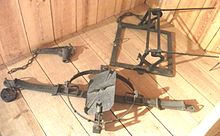- Mantrap
-
Mantraps are physical security devices or constructions designed to entrap a human on purpose.
Contents
Historical usage
Historically, mantraps were mechanical devices for catching poachers and trespassers. The devices have taken many forms, the most usual being like a large foothold trap, the steel springs being armed with teeth which met in the victim's leg. Since 1827, they have been illegal in England, except in houses between sunset and sunrise as a defence against burglars.[1]
Also, other traps such as special snares, trap netting, trapping pits, fluidizing solid matter traps[2] and cage traps could be used.
Mantraps that use deadly force are illegal in the United States, and there have been notable tort law cases where the trespasser has successfully sued the property owner for damages caused by the mantrap. As noted in the important US court case of Katko v. Briney, "the law has always placed a higher value upon human safety than upon mere rights of property."[3]
Modern usage
A man trap in modern physical security protocols refers to a small space having two sets of interlocking doors such that the first set of doors must close before the second set opens. Identification may be required for each door, sometimes even possibly different measures for each door. For example, a key may open the first door, but a personal identification number entered on a number pad opens the second. Other methods of opening doors include proximity cards or biometric devices such as fingerprint readers or iris recognition scans. Metal detectors are often built in in order to prevent entrance of people carrying weapons. Such use is particularly frequent in banks and jewellery shops. Mantraps may be configured so that when an alarm is activated, all doors lock and trap the suspect between the doors in the "dead space" or lock just one door to deny access to a secure space such as a data center or research lab.
In a lower security variation of a mantrap, banks often locate automated teller machines within the dead space between the entrance doors and the interior lobby doors to prevent ATM robbery and night walk-up robberies. Entry access by ATM card to the dead space offers additional customer protection. They are also known as air locks in the security industry.
Footnotes
- ^ B2 Non Fatal Offences Against the Person - March 2008, Oxford University Press, March 2008
- ^ Fluidized sand mantrap
- ^ "Katko v. Briney". 183 N.W.2d 657. (Iowa Sup. Ct. 1971).
See also
- Animal trapping
- Sally port
- Spring gun
- Katko v. Briney (important case on mantrap liability in the United States)
- Booby trap
- Access control vestibule
External links
 Media related to Mantrap at Wikimedia Commons
Media related to Mantrap at Wikimedia CommonsSources
 This article incorporates text from a publication now in the public domain: Chisholm, Hugh, ed (1911). Encyclopædia Britannica (11th ed.). Cambridge University Press.Categories:
This article incorporates text from a publication now in the public domain: Chisholm, Hugh, ed (1911). Encyclopædia Britannica (11th ed.). Cambridge University Press.Categories:
Wikimedia Foundation. 2010.

